Road signs in the United Kingdom
Road signs in the United Kingdom and in its associated Crown dependencies and overseas territories conform broadly to European design norms, though a number of signs are unique: direction signs omit European route numbers and road signs generally use the Imperial System of units (miles and yards), unlike the rest of Europe (km and m).

A range of signs are used on British roads such as destination signposts, signs warning of possible hazards ahead, and regulatory signs instructing road users to perform specific actions.
History
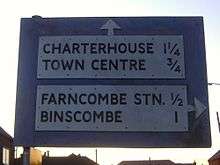
.jpg)
Modern British road signage can be traced to the development of the "ordinary" bicycle and the establishment of clubs to further the interests of its riders, notably the Cyclists' Touring Club (CTC), the National Cyclists' Union (NCU) and the Scottish Cyclists' Union (SCU). By the early 1880s, all three organisations were erecting their own cast-iron "danger boards". Importantly, these signs warned of hazards, rather than just stating distances or giving direction to places, acknowledging the fact that cyclists, like modern motorists, were unlikely to be familiar with the roads they were travelling along and were moving too fast to take avoiding action without prior warning. In addition, it was the cycling lobby that successfully pressured the government in 1888 into vesting ownership of and responsibility for roads with county councils in previously established highway districts that would be funded from taxation rather than tolls. The districts were active in the erection of semi-standardised directional signs and mileposts in the latter years of the 19th century.
The rise of motoring after 1896 saw the pattern repeated. The larger motoring clubs, notably The Automobile Association (AA) and the Royal Scottish Automobile Club (RSAC) erected their own, idiosyncratic warning boards and direction signs on a wide scale. Under the Motor Car Act 1903 four national signs were created which were to be set at least 8 ft (2.4 m) from the ground and 50 yards (46 m) from their reference point. These signs were distinguished based on their shape, rather than a symbol or writing on them. These included a white ring meaning speed limited (as marked on a small information plate below it); a white (sometimes red) diamond for a "motor notice" such as a weight restriction (given on a plate below); a red disc for a prohibition; and a red open triangle for a hazard or warning. The latter two could provide more detail by having an information plate below them, but often it was left to the motorist to guess what the sign was referring to, and it was common to have variations between different local areas for what was a prohibition or just a "notice". This format was to develop into the British road sign that was standard from 1934 until 1964. Before this time regulations for traffic signs were published under powers created by the Road Traffic Act 1930 and so national road signage specifications were only advisory.[1]

Following a review of national signage in 1921, a limited number of warning and hazard information plates also used symbols, rather than only text. Such symbols had been developed in continental Europe as early as 1909, but before this had been dismissed by the UK which favoured the use of text. The symbols were simple silhouettes which were easy to recognise at a distance. Some were unusual, such as 'SCHOOL' (and later 'CHILDREN') was depicted by the 'flaming torch of knowledge'. The government made increasing efforts to standardise road signs in the Road Traffic Act 1930 (RTA) and regulations of 1933, being finally consolidated with the publication of the 1934 Road Traffic Acts and Regulations handbook. These saw the end of non-standard permanent signs being erected by motoring clubs, such as the black and yellow vitreous enamel AA signs (although this did not include temporary direction signs). While the RSAC had ceased erecting signs, the Royal Automobile Club (RAC) had begun to do so to RTA specifications (save for the inclusion of the RAC badge) and was very active in this respect in the late-1930s.
.jpg)
The 1934 national British signs included: a red disc (for a prohibition), a red open triangle (for a warning or hazard), a red ring (for an order), and a red open triangle in a circle for a new warning with an order (which had the plates 'SLOW - MAJOR ROAD AHEAD' and 'HALT AT MAJOR ROAD AHEAD', the predecessors of 'GIVE WAY' and 'STOP' signs respectively). All signs were to carry information plates mounted below them, which were illustrated with a wide range of prescribed standardised symbols, and only text when no symbol existed. The lettering and symbols were black on a white background, except for orders (like 'TURN LEFT') which were white on blue. New to the UK were the first combination sign, which incorporated information on the sign itself, the 30 miles per hour speed restriction (introduced in 1934), with '30' in black letters on a white disc surrounded by a red ring, to indicate it is an order sign. The 30 mph sign was accompanied by its 'derestriction' sign, a white disc with a diagonal black band bisecting it, which marked the end of the restriction. Neither of these signs required separate information plates. The 1934 RTA&R also clarified direction and distance signage, which remained in that form until 1964. All signs were mounted on posts painted in black and white stripes, and their reverse sides were finished black, green, or more rarely (usually after repainting) white. The 'HALT' plate was unique in being T-shaped; orders were mainly landscape and warnings always portrait. Sizes were strictly prescribed, the warning plate being 21 by 12 inches (53 cm × 30 cm) with the surmounting triangle 18 inches (46 cm) equal.

As part of its anti-invasion preparations during World War II, the British government instructed all navigational signposts and railway station signs to be removed, so as not to aid potential enemy ground movements.[3] After the war ended, larger motoring associations embarked upon a programme to erect temporary road signs. These temporary signs, which were not required to conform to the standardisation laid down by the government, usually displayed the motoring association’s logo and colour-scheme.
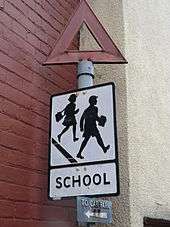
The national signs were subject to minor modification, mainly in the early post-World War II years. For instance, 'SCHOOL' became a schoolboy and girl marching off a kerb, 'CHILDREN' a boy and girl playing handball on a kerb's edge. A train 'CROSSING NO GATES' was given a more toy-like locomotive. Meanwhile, the triangle was inverted for 'HALT' and 'SLOW', while 'NO ENTRY' became a combination sign - a red disc bisected by a horizontal white rectangle bearing the lettering. Orders were now black on white, save for 'NO WAITING', which was black on yellow in a red ring. Some of these changes were part of an attempt to reflect European standards.
Early road signs were usually cast iron, but this was increasingly displaced by cast aluminium in the 1930s. Cast signs were designed to be maintained by being repainted with the raised lettering and symbol easily picked out by an untrained hand. This sort of sign was sometimes given an element of night use by the inclusion of glass reflectors. An alternative to casting and painting was vitreous enamelled sheet iron or steel. In the 1950s cast signs were quickly displaced by sheet metal (usually aluminium) coated with adhesive plastics; these could be made reflective, famously by Scotchlite. Such signs had become almost universal by the reforms of the early 1960s.
The major reform of UK road signage to better reflect European practice happened in two stages. The first was associated with the first motorway construction project and the development of a signage system for it by the Anderson Committee of 1957. Although it was additional to the existing signage, it set several benchmarks that were developed under the Worboys Committee of 1963 that was largely responsible for the road signage system effected from 1964, which is still current. Until Worboys, the most notable differences between European and UK signs was the use of symbols without text wherever possible, thereby increasing the internationalism of their meaning, and with their combined nature, such as warning signs having the symbol inside the triangle instead of on a separate information plate, on the continent. The Worboys Committee recommended that such practices were adopted in the UK and the 'New Traffic Signs' of 1964 were part of the most comprehensive reformation of the UK streetscape ever. Unlike previous government efforts to regulate signage, which tended to be cumulative, Worboys argued a modernist position of starting from a clean slate, with all previous signs being deemed obsolete, illegal even, therefore subject to total and systematic replacement. As a result, local authorities were charged with massive resignage programmes. Order and Prohibition signs were almost all replaced within a couple of years, with the warning and direction signs taking a longer amount of time. Few pre-1964 warning signs survived more than about ten years and while direction signs were similarly replaced more have survived as they were not deemed as essential.
The system currently in use was mainly developed in the late 1950s and the early 1960s, with additional colour-coding introduced in the mid-1980s. There were three major steps in the development of the system.
- The Anderson Committee established the motorway signing system.
- The Worboys Committee reformed signing for existing all-purpose roads.
- The Guildford Rules introduced features to indicate different categories of route.
Anderson Committee
In 1957, a government committee was formed to design signs for the new motorway network. A system was needed that could be easily read at high speed. Colin Anderson, chairman of P&O, was appointed chairman; T. G. Usborne, of the Ministry of Transport, had charge of proceedings. Two graphic designers were commissioned to design the system of signage: Jock Kinneir and his assistant (and later business partner) Margaret Calvert. The new signs were first used on the Preston bypass in 1958.[4]
Worboys Committee
The UK government formed another committee in 1963 to review signage on all British roads. It was chaired by Sir Walter Worboys of Imperial Chemical Industries. The result was a document that defined traffic signing in Britain, the Traffic Signs Regulations and General Directions (TSRGD). It was first introduced on 1 January 1965 but has been updated many times since. It is comparable with the Manual on Uniform Traffic Control Devices in the United States. The TSRGD is a Statutory Instrument that prescribes the sign faces and permitted variants that may be used on UK roads. The TSRGD is supported by the Traffic Signs Manual[5] (TSM), which consists of eight separately-published chapters which provide "the codes to be followed in the use, siting, and illumination of signs both on all-purpose roads and motorways. It also covers temporary signs for use in connection with road works, in an emergency by the police, and temporary route signing by motoring organisations and highway authorities."
Design
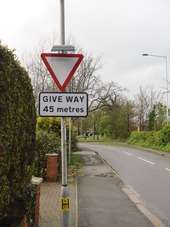
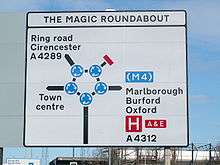
Detailed guidelines govern road signs in the United Kingdom. The basic units of measurement used by sign designers and typographers are the 'x-height' (the height of the lower case letter 'x') and the 'stroke width' (sw) (4 sw = 1 x-height). The sizes of borders, symbols and arrows and the spacing and layout of the sign face are expressed in sw, so that all the elements remain in proportion. The x-height of a sign is dictated mainly by the speed of traffic approaching it; hence 300 mm (12 inches) x-heights are common on motorways, whereas parking signs are mostly at 15 mm (1⁄2 inch) or 20 mm (3⁄4 inch) x-height.[6]
Shape
Almost all signs have rounded corners. This is partly for aesthetic reasons. It is also safer for anyone coming into contact with a sign, and it makes the sign more durable, as rain and snow are less likely to corrode the corners.
Units of measurement
The United Kingdom uses mostly imperial units on road signs for distance measurements and speed limits.[7] Vehicle weight limits are signed only in metric (TSRGD 1981), and metric units may be used in addition to imperial ones for height, width and length restrictions.
From March 2015, all new height and width restrictions are to have dual metric-imperial units.[8]
Colours
Three colour combinations are used on Worboys direction signs depending upon the category of the route. All roads are categorised as either motorways (white on blue), primary routes (white on dark green with yellow route numbers), or non-primary routes (black on white).[9][10]
TSRGD 1994 also prescribed a system of white-on-brown direction signs for tourist and recreational attractions. TSRGD 2002[11] updated this and introduced a system of black-on-yellow signs for roadworks. TSRGD 2016 is the current version in force.
On Advance Direction Signs, as introduced under the Guildford Rules, the background colour indicates the category of route on which it is located.[10] On all directional signs, destination names are placed on the colour appropriate to the category of route used from that junction.[10] A panel of one colour on a different colour of background, therefore, indicates a change of route status.[10] A smaller area of colour, called a patch, surrounds a bracketed route number (but not its associated destination) to indicate a higher status route that is joined some distance away.[10] A patch may only be coloured blue or green.[10]

Signs indicating a temporary change, such as roadworks or route diversions, are denoted with a yellow background. Usually, these signs use a simple black on yellow colour code, more complex signage use the conventional signs superimposed onto a yellow background.
In some areas, such as the Dartmoor National Park, additional signs and colours are used to distinguish road conditions. In addition to the national colour schemes, the park also uses white signs with a light blue border and text to denote routes suitable for medium-sized vehicles and white signs with a brown border and text for routes suitable for cars and small vehicles only. The park also uses fingerpost signs for routes suitable for local traffic only. These routes are publicised in park leaflets and other media.[12]
For ease of reference, the main colour-coding rules may be summarised as below:
| Sign background | Border | Lettering | Usage | Ruleset |
|---|---|---|---|---|
| Blue | White | White | Motorways M1, A1(M) | Anderson |
| Green | White | White (with yellow route numbers) | Primary routes A2 | Worboys |
| White | Black | Black | Non-primary routes A335, B190 | Worboys |
| White | Black | Black | Local destinations | |
| White | Blue | Black | Local destinations | Worboys, now defunct and replaced by above |
| Brown | White | White | Tourist attractions | |
| Black | White | White | HGV routes | |
| White | Red | Black | Ministry of Defence sites | |
| Yellow | Black | Black | Temporary/Diversion | Guildford |
The colour-coding for panels on signs may be summarised as below:
| Panel background | Border | Lettering | Usage | Ruleset |
|---|---|---|---|---|
| Blue | White | White | Motorways | Guildford |
| Green | White | White | Primary routes | Guildford |
| Brown | White | White | Tourist attractions | Guildford |
| White | Red | Black | Ministry of Defence sites | Guildford |
Typefaces
Two typefaces are specified for British road signs: Transport and Motorway.
Transport is a mixed-case font and is used for all text on fixed permanent signs except route numbers on motorway signs.[6] It is used in two weights: Transport Medium (for light text on dark backgrounds) and Transport Heavy (for dark text on light backgrounds).[6]
Motorway has a limited character set consisting of just numbers and a few letters and symbols needed to show route numbers; it has elongated characters and is designed to add emphasis to route numbers on motorways.[6] Motorway is used to sign all route numbers on motorways themselves, and may also be used on non-motorway roads to sign directions in which motorway regulations apply immediately (such as motorway slip roads). Motorway Permanent is light characters on a dark background; Motorway Temporary is dark on light.
Transport Medium and Motorway Permanent were developed for the Anderson Committee and appeared on the first motorway signs. The other two typefaces are similar but have additional stroke width in the letters to compensate for light backgrounds. These typefaces are the only ones permitted on road signs in the UK. Although signs containing other typefaces do appear occasionally in some places, they are explicitly forbidden in government guidelines and are technically illegal.
Language
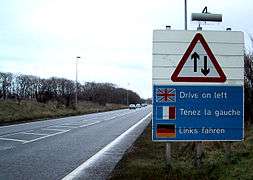
Bilingual signs are used in Wales. Welsh highway authorities, until 2016, could choose whether the signs in their area were "English-priority" or "Welsh-priority", and the language having priority in each highway authority's area appeared first on signs. Most of south Wales used English-priority while western, mid, and most of northern Wales were Welsh-priority. New regulations that came into force in 2016 mandate all signs to be in Welsh first, with the existing "English-priority" signage being replaced only when they otherwise would.[13] Bilingual signs were permitted by special authorisation after 1965, and in 1972 the Bowen Committee recommended that they should be provided systematically throughout Wales.
A small number of multilingual signs exist in the UK on major roads that leave major ports (such as the Port of Dover). They give the UK standard speed limits and remind drivers to drive on the left, in English, French, and German. Multilingual 'no stopping' signs exist in several locations on the M25.
In the Scottish Highlands and Islands, many road signs have Scottish Gaelic in green, in addition to English in black. This is part of the Gaelic language revival encouraged by many, including the Scottish Government and Bòrd na Gàidhlig.
Retroreflection
Road signs in the UK must be retroreflective in order for drivers to read them at night.[14] There are three commonly used grades of materials used:
- Class 1 (engineering grade) is a low-performance glass bead product, it was the first reflective material used on the UK network and invented by 3M. Today in the UK it is used only for street nameplates and parking signs.
- Class 2 (high-intensity) is generally a microprismatic product which uses truncated cube corners to return light to the driver. It is commonly used for directional signs or less important regulatory signs. There are also high-intensity glass bead products that meet this class.
- Class 3 (diamond grade) is a high end microprismatic product for important signs, those on high-speed roads and in areas of ambient lighting where a driver may be distracted by the light clutter. Class 3 can be divided into two divisions; 3A for long distance and 3B for short distance. Currently, the only product that performs to these levels is Diamond Grade DG3.
Categorisation
Road signs, markings and signals in the United Kingdom are formally categorised into sets, identifiable by the design number:
- Warning signs (5xx)
- Regulatory signs (6xx)
- Level crossing signs (7xx)
- Information signs (8xx)
- Bus, tram & cycle signs (9xx)
- Road markings (1xxx)
- Direction signs (2xxx)
- Traffic signals (3xxx)
- Signals for crossing facilities (4xxx)
- Lane control signs (5xxx)
- Road works signs (7xxx)
For clarity, signs are more commonly grouped together below
Warning signs
The importance of a warning sign is emphasised by the red border around its edge and the triangular shape. Some warning signs do not have a red border like sharp deviation. The priority of traffic through the junction is indicated by the broader line. Examples below exclude low bridges, railway and tramway level crossings, bus and pedal cycle facilities, traffic calming and road works.
 STOP or GIVE WAY ahead
STOP or GIVE WAY ahead Plate use with "STOP" triangle to give the distance to STOP line
Plate use with "STOP" triangle to give the distance to STOP line Plate used with "GIVE WAY" sign to give the distance to GIVE WAY line
Plate used with "GIVE WAY" sign to give the distance to GIVE WAY line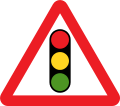 Traffic signals ahead
Traffic signals ahead Plate used with "traffic signals" for traffic signals that operate only at certain times
Plate used with "traffic signals" for traffic signals that operate only at certain times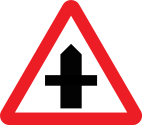 Crossroads
Crossroads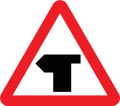 T-junction
T-junction Side road
Side road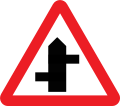 Staggered junction
Staggered junction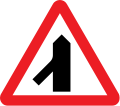 Traffic merges from the left
Traffic merges from the left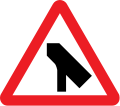 Traffic merges onto the main carriageway
Traffic merges onto the main carriageway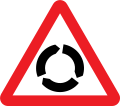 Roundabout
Roundabout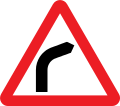 Bend to right (left if symbol reversed)
Bend to right (left if symbol reversed)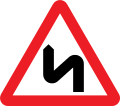 Double bend first to the left (right if symbol reversed)
Double bend first to the left (right if symbol reversed)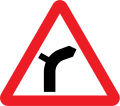 Junction on a bend (symbols may be reversed)
Junction on a bend (symbols may be reversed)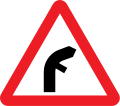 Junction on a bend (symbols may be reversed)
Junction on a bend (symbols may be reversed) Plate used with "roundabout" or "bend" signs
Plate used with "roundabout" or "bend" signs Sharp deviation of route to the left (right if chevrons reversed)
Sharp deviation of route to the left (right if chevrons reversed) Plate used with warning signs where a reduction in speed is necessary
Plate used with warning signs where a reduction in speed is necessary Advisory speed limit in miles per hour
Advisory speed limit in miles per hour Road narrows on both sides
Road narrows on both sides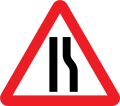 Road narrows on right (left if symbol reversed)
Road narrows on right (left if symbol reversed)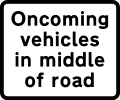 Oncoming traffic will be in the middle of the road
Oncoming traffic will be in the middle of the road Single file traffic in each direction
Single file traffic in each direction Road wide enough for only one line of vehicles
Road wide enough for only one line of vehicles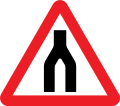 End of dual carriageway
End of dual carriageway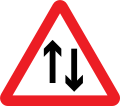 Two-way traffic
Two-way traffic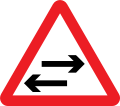 Two-way traffic on route crossing ahead
Two-way traffic on route crossing ahead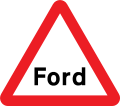 Worded warning "Ford" may be varied to "Flood", "Gate", "Gates" or "No smoking"
Worded warning "Ford" may be varied to "Flood", "Gate", "Gates" or "No smoking" Try brakes after crossing a ford or before descending a steep hill
Try brakes after crossing a ford or before descending a steep hill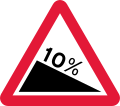 Steep hill downwards (10% is equivalent to 1:10)
Steep hill downwards (10% is equivalent to 1:10)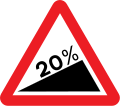 Steep hill upwards (20% is equivalent to 1:5)
Steep hill upwards (20% is equivalent to 1:5) Plates used with "steep hill" signs
Plates used with "steep hill" signs Plates used with "steep hill" signs
Plates used with "steep hill" signs Plates used with "steep hill" signs
Plates used with "steep hill" signs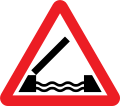 Opening of swing bridge
Opening of swing bridge Quayside or river bank
Quayside or river bank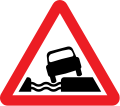 Water course alongside road
Water course alongside road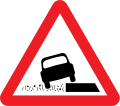 Soft verges
Soft verges Plate used with "soft verges" for distance shown
Plate used with "soft verges" for distance shown Tunnel
Tunnel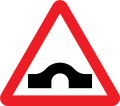 Hump bridge
Hump bridge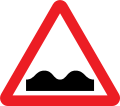 Uneven road
Uneven road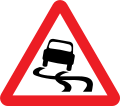 Slippery road
Slippery road Side winds
Side winds Distance to hazard
Distance to hazard Distance and direction to hazard
Distance and direction to hazard Distance over which hazard extends
Distance over which hazard extends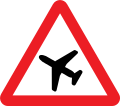 Low-flying aircraft or sudden aircraft noise
Low-flying aircraft or sudden aircraft noise Gliders likely
Gliders likely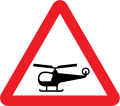 Low-flying helicopters or sudden helicopter noise
Low-flying helicopters or sudden helicopter noise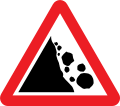 Risk of falling or fallen rocks
Risk of falling or fallen rocks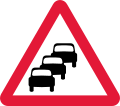 Traffic queues likely ahead
Traffic queues likely ahead Traffic queues likely ahead
Traffic queues likely ahead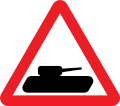 Slow-moving military vehicles likely to be in or crossing the road
Slow-moving military vehicles likely to be in or crossing the road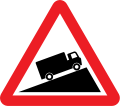 Slow-moving vehicles ahead
Slow-moving vehicles ahead Plate for "slow-moving vehicles" to show distance over which slow lorries extends
Plate for "slow-moving vehicles" to show distance over which slow lorries extends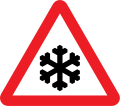 Ice or Snowdrifts
Ice or Snowdrifts Plate used with "ice". may be varied to "snowdrifts"
Plate used with "ice". may be varied to "snowdrifts" Other danger ahead. This sign must be accompanied by an information plate specifying the nature of the danger.
Other danger ahead. This sign must be accompanied by an information plate specifying the nature of the danger. Fire station ahead, STOP when lights show. "FIRE" may be varied to "AMBULANCE"
Fire station ahead, STOP when lights show. "FIRE" may be varied to "AMBULANCE" Plate indicates nature of the hazard
Plate indicates nature of the hazard
 Pedestrians ahead
Pedestrians ahead Pedestrians in road for distance shown
Pedestrians in road for distance shown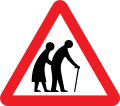 Frail pedestrians likely to cross
Frail pedestrians likely to cross Disabled pedestrians. "Disabled" may be varied to "Blind"
Disabled pedestrians. "Disabled" may be varied to "Blind" Children going to or from school
Children going to or from school Plate used with "school" sign
Plate used with "school" sign Alternative plates used with "school" sign
Alternative plates used with "school" sign Alternative plates used with "school" sign
Alternative plates used with "school" sign Alternative plates used with "school" sign
Alternative plates used with "school" sign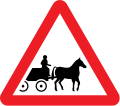 Horse-drawn vehicles likely to be in the road
Horse-drawn vehicles likely to be in the road Accompanied horses or ponies likely to be in or crossing the road
Accompanied horses or ponies likely to be in or crossing the road Wild horses or ponies
Wild horses or ponies Wild animals
Wild animals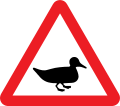 Wildfowl
Wildfowl Migratory toad crossing
Migratory toad crossing Sheep
Sheep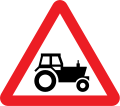 Agricultural vehicles
Agricultural vehicles Agricultural vehicles
Agricultural vehicles Area infected by animal disease
Area infected by animal disease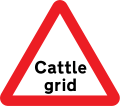 Cattle grid
Cattle grid Plate used with "cattle grid" for indication of bypass for horse-drawn vehicles and animals
Plate used with "cattle grid" for indication of bypass for horse-drawn vehicles and animals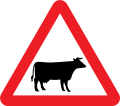 Cattle
Cattle Plate used with "cattle" to indicate supervised cattle crossing ahead
Plate used with "cattle" to indicate supervised cattle crossing ahead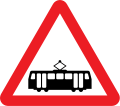 Trams likely to be crossing ahead
Trams likely to be crossing ahead
Regulatory signs
Signs in circular red borders are prohibitive, whether or not they also have a diagonal red line. Circular blue signs mainly give a positive (mandatory) instruction. Such circular signs may be accompanied by, or place on, a rectangular plate (information) that provides details of the prohibition or instruction; for example, waiting and loading plates and zone entry signs.
'Stop' signs (octagonal) and 'give way' signs (inverted triangle) are the two notable exceptions, the distinctive shapes being recognisable even if the face is obscured by dirt or snow.
 Stop before crossing the traverse line on the road and ensure the way is clear before entering a major road
Stop before crossing the traverse line on the road and ensure the way is clear before entering a major road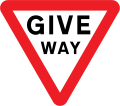 Give way to traffic on the major road (English Language Only)
Give way to traffic on the major road (English Language Only).svg.png) Give way to traffic on the major road (English and Welsh Language)
Give way to traffic on the major road (English and Welsh Language) No Entry for vehicular traffic. An exception plate may not accompany this sign
No Entry for vehicular traffic. An exception plate may not accompany this sign All vehicles prohibited. This sign may additionally display an exception plate (for example: 'Except Cycles')
All vehicles prohibited. This sign may additionally display an exception plate (for example: 'Except Cycles') Plate used on "vehicles prohibited" All vehicles prohibited
Plate used on "vehicles prohibited" All vehicles prohibited Plate for "vehicles prohibited", during the time indicated except for access
Plate for "vehicles prohibited", during the time indicated except for access Plate for "vehicles prohibited", all vehicles prohibited from 'Play Street' during the period indicated except for access
Plate for "vehicles prohibited", all vehicles prohibited from 'Play Street' during the period indicated except for access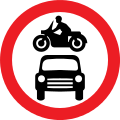 Motor vehicles prohibited (that is: excluding non-mechanically propelled vehicles being pushed by pedestrians)
Motor vehicles prohibited (that is: excluding non-mechanically propelled vehicles being pushed by pedestrians) Motor vehicles except solo motorcycles prohibited
Motor vehicles except solo motorcycles prohibited Solo motorcycles prohibited
Solo motorcycles prohibited Towed caravans prohibited
Towed caravans prohibited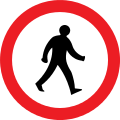 Pedestrians prohibited
Pedestrians prohibited Ridden or accompanied horses prohibited
Ridden or accompanied horses prohibited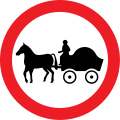 Horse-drawn vehicles prohibited
Horse-drawn vehicles prohibited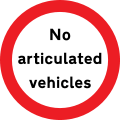 Articulated vehicles prohibited
Articulated vehicles prohibited.svg.png) Goods vehicles exceeding an unladen weight of 7.5 t prohibited
Goods vehicles exceeding an unladen weight of 7.5 t prohibited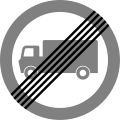 End of prohibition of goods vehicles exceeding the maximum unladen weight indicated in a previous sign
End of prohibition of goods vehicles exceeding the maximum unladen weight indicated in a previous sign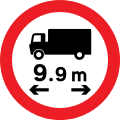 Vehicles exceeding length indicated prohibited (metric)
Vehicles exceeding length indicated prohibited (metric)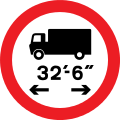 Vehicles exceeding length indicated prohibited (imperial)
Vehicles exceeding length indicated prohibited (imperial) Vehicles carrying explosives (such as fireworks) prohibited
Vehicles carrying explosives (such as fireworks) prohibited Plate used on "vehicles carrying explosives"
Plate used on "vehicles carrying explosives" Vehicles exceeding width indicated prohibited (imperial and metric)
Vehicles exceeding width indicated prohibited (imperial and metric)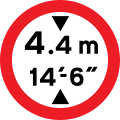 Vehicles exceeding height indicated prohibited (imperial and metric)
Vehicles exceeding height indicated prohibited (imperial and metric).svg.png) Vehicles exceeding a gross weight of 33 t prohibited from crossing the bridge or structure
Vehicles exceeding a gross weight of 33 t prohibited from crossing the bridge or structure Plate for any regulation sign except for access to premises or land adjacent to the road, where there is no other route. Other exemptions may be shown
Plate for any regulation sign except for access to premises or land adjacent to the road, where there is no other route. Other exemptions may be shown Except for loading and unloading by goods vehicles
Except for loading and unloading by goods vehicles No overtaking
No overtaking Priority must be given to vehicles from the opposite direction
Priority must be given to vehicles from the opposite direction Plate for "Oncoming vehicles"
Plate for "Oncoming vehicles"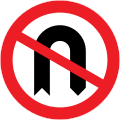 No U-turns for vehicular traffic
No U-turns for vehicular traffic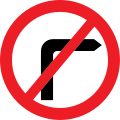 No right turn for vehicular traffic
No right turn for vehicular traffic No left turn for vehicular traffic
No left turn for vehicular traffic Stop, children crossing ahead (This sign can only displayed by a person at a patrolled crossing).
Stop, children crossing ahead (This sign can only displayed by a person at a patrolled crossing).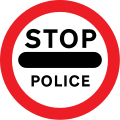 Stop before crossing, Police ahead
Stop before crossing, Police ahead
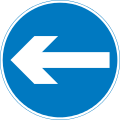 Vehicular traffic must turn left (right if symbol reversed)
Vehicular traffic must turn left (right if symbol reversed)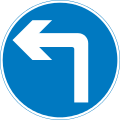 Vehicular traffic must turn ahead in the direction indicated by the arrow
Vehicular traffic must turn ahead in the direction indicated by the arrow Vehicular traffic passing the sign must keep to the left of the sign (right if symbol reversed)
Vehicular traffic passing the sign must keep to the left of the sign (right if symbol reversed) Dual carriageway Plate
Dual carriageway Plate One-way plate
One-way plate Mini-roundabout (give way to traffic from the immediate right)
Mini-roundabout (give way to traffic from the immediate right) No Waiting or No Parking
No Waiting or No Parking Clearway, no stopping
Clearway, no stopping One-way traffic
One-way traffic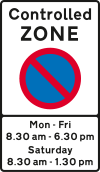
 End of controlled or voucher parking zone
End of controlled or voucher parking zone
Speed Limit Signs
The United Kingdom national speed limit for cars and motorcycles is 70 miles per hour on a motorway and dual carriageway, and 60 miles per hour on a single carriageway road. In urban areas where there is electric street lighting the speed limit is 30 miles per hour unless otherwise signed.[15][16]
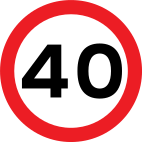 Maximum speed limit of 40 miles per hour
Maximum speed limit of 40 miles per hour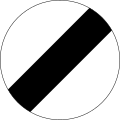 National speed limit applies
National speed limit applies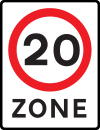 Entrance to a 20 miles per hour speed limit zone
Entrance to a 20 miles per hour speed limit zone End of 20 miles per hour zone
End of 20 miles per hour zone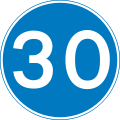 Minimum speed limit of 30 miles per hour
Minimum speed limit of 30 miles per hour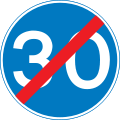 End of 30 miles per hour minimum speed limit
End of 30 miles per hour minimum speed limit Speed camera ahead with reminder of 30 miles per hour speed limit
Speed camera ahead with reminder of 30 miles per hour speed limit Area in which cameras are used to enforce the speed limit regulations
Area in which cameras are used to enforce the speed limit regulations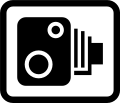 Speed Camera
Speed Camera.svg.png) Average speed check
Average speed check National speed limits
National speed limits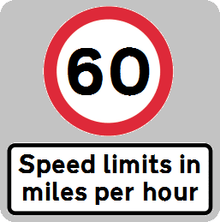 National speed limits (Northern Ireland Only)
National speed limits (Northern Ireland Only)
Low Bridge Signs
Bridges with a clearance of less than 16 feet 7 inches (5.05 m) are normally signed. Signs were formerly only in feet and inches, but form 2015 new or replacement signs must contain both imperial and metric measurements. The signs used at a low bridge depend on the type above the road. If a beam bridge with a horizontal clearance, the roundel is used and the limit is a prohibition. However if the bridge is an arch over the road, warning signs are used as the height varies across the width of the carriageway. Bridges particularly at risk from strikes may have a variable message sign that is activated by high vehicles passing through an infra-red beam. When the sign is activated four amber lamps flash, the top pair alternating with the bottom pair.
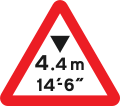 Warning of maximum headroom of arch bridge/overhanging structure some distance ahead (sign also used at the bridge itself)
Warning of maximum headroom of arch bridge/overhanging structure some distance ahead (sign also used at the bridge itself) Supplementary plate informing height limit warning is of an overhanging building
Supplementary plate informing height limit warning is of an overhanging building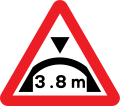 Warning of maximum headroom of arch bridge directly ahead (metric)
Warning of maximum headroom of arch bridge directly ahead (metric)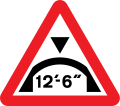 Warning of maximum headroom of arch bridge directly ahead (imperial)
Warning of maximum headroom of arch bridge directly ahead (imperial)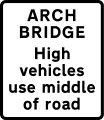 Supplementary plate used with arch bridge warning signs
Supplementary plate used with arch bridge warning signs Height restriction (metric and imperial)
Height restriction (metric and imperial)
Level crossing Signs
Some level crossings in the United Kingdom do not have gates or barriers. These crossings will have several signs posted on approach and at the crossing.
 Level crossing with gate or barrier ahead
Level crossing with gate or barrier ahead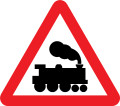 Railway level crossing without gate or barrier ahead
Railway level crossing without gate or barrier ahead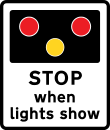 Warning of light signals at a level crossing ahead (the sign may also be used at a lifting bridge or airfield)
Warning of light signals at a level crossing ahead (the sign may also be used at a lifting bridge or airfield) Electrified overhead cable ahead
Electrified overhead cable ahead Supplementary plate informing height of overhead cables at level crossing ahead
Supplementary plate informing height of overhead cables at level crossing ahead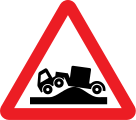 Risk of grounding at level crossing ahead
Risk of grounding at level crossing ahead Information sign for large vehicles informing to phone at automatic level crossing
Information sign for large vehicles informing to phone at automatic level crossing Information sign for very large vehicles to phone before crossing railway
Information sign for very large vehicles to phone before crossing railway Direction to telephone at level crossing
Direction to telephone at level crossing Telephone at level crossing
Telephone at level crossing Countdown marker to level crossing (3)
Countdown marker to level crossing (3) Countdown marker to level crossing (2)
Countdown marker to level crossing (2) Countdown marker to level crossing (1)
Countdown marker to level crossing (1) Supplementary plate warning drivers to not block the level crossing
Supplementary plate warning drivers to not block the level crossing Supplementary plate at multiple track automatic level crossings warning of a second train
Supplementary plate at multiple track automatic level crossings warning of a second train Ungated level crossing
Ungated level crossing
Bus and cycle signs
Some roads and pavements are shared with cyclists and buses. The word "local" on the bus symbol means the only buses that may use the lane are those running a local service. Where the word "local" is not shown, the lane may be used by any vehicle designed to carry more than eight passengers, excluding the driver, and local buses. Solo motorcycles may use the lane where the motorcycle symbol is shown on the signs. Other vehicles may enter and stop in a bus lane to load and unload unless signs alongside the lane indicate otherwise.
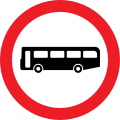 Buses prohibited
Buses prohibited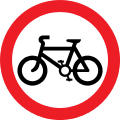 Riding of pedal cycles prohibited
Riding of pedal cycles prohibited (Undivided) shared path route for cyclists and pedestrians only
(Undivided) shared path route for cyclists and pedestrians only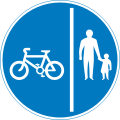 Divided track for cyclists and pedestrians only
Divided track for cyclists and pedestrians only Route for use by pedal cycles only
Route for use by pedal cycles only Route for use by tramcars only
Route for use by tramcars only Route for use by buses and tramcars only
Route for use by buses and tramcars only Contra-flow bus lane
Contra-flow bus lane Route recommended for pedal cycles on the main carriageway of a road
Route recommended for pedal cycles on the main carriageway of a road End of bus lane
End of bus lane Junction ahead leading to a parking place for pedal cycles
Junction ahead leading to a parking place for pedal cycles With flow cycle lane
With flow cycle lane Bus lane with traffic proceeding from both ways (reminder for pedestrians)
Bus lane with traffic proceeding from both ways (reminder for pedestrians) With-flow cycle lane ahead
With-flow cycle lane ahead Parking place for buses only during the times shown
Parking place for buses only during the times shown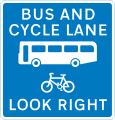 Contra-flow bus lane which pedal cycles may also use with traffic approaching from the right (reminder for pedestrians)
Contra-flow bus lane which pedal cycles may also use with traffic approaching from the right (reminder for pedestrians)
Pedestrian zone signs
Areas such as high streets and shopping areas may be signed as "pedestrian zones". Restrictions are detailed on zone entry signs and repeater plates. The entry signs may indicate that buses, taxis, disabled badge holders or permit holders may enter the zone. Examples of zone entry signs include:
 Entry to and waiting in pedestrian zone restricted except for loading during the period
Entry to and waiting in pedestrian zone restricted except for loading during the period End of restrictions associated with a pedestrian zone
End of restrictions associated with a pedestrian zone Waiting restriction repeater signs within the pedestrian zone
Waiting restriction repeater signs within the pedestrian zone
Loading bays and Parking signs
Both signs and road markings indicate waiting restrictions. On-street parking places may be designated for a particular class of vehicle (e.g. solo motorcycles or car) or a specific type of user (e.g. permit holders or disabled badge holders). Parking may be free or paid for (e.g. "pay and display" or parking meters).
There may be a time limit on the period of stay and a minimum time before returning to a particular parking place. Where a plate does not indicate the days of the week, the restrictions apply at the same times on every day, including Sunday. Where the time of day is not shown, the controls apply for 24 hours. If a bank holiday falls on a day when the controls are in operation, the controls apply in the normal way unless the plate states that they do not. Special restrictions may apply on days when a large event is being held.
 Waiting prohibited except for loading and unloading during the period indicated
Waiting prohibited except for loading and unloading during the period indicated Waiting prohibited except for loading and unloading during the period and in the direction indicated
Waiting prohibited except for loading and unloading during the period and in the direction indicated Waiting prohibited in designated off-highway loading area during the period indicated
Waiting prohibited in designated off-highway loading area during the period indicated Continuous prohibition on loading and unloading
Continuous prohibition on loading and unloading Bay reserved for loading and unloading only
Bay reserved for loading and unloading only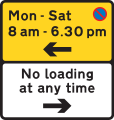 Waiting prohibited in the direction indicated (upper panel), and loading and unloading prohibited in the direction indicated (lower panel)
Waiting prohibited in the direction indicated (upper panel), and loading and unloading prohibited in the direction indicated (lower panel)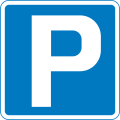 Parking place
Parking place Parking place reserved for disabled badge holders only
Parking place reserved for disabled badge holders only Parking for all vehicles, with restrictions on length of waiting time and return period (not necessarily free, though the sign must state if not free)
Parking for all vehicles, with restrictions on length of waiting time and return period (not necessarily free, though the sign must state if not free) Parking place reserved for voucher parking during the period indicated
Parking place reserved for voucher parking during the period indicated Direction to a parking place available only on the day specified
Direction to a parking place available only on the day specified Vehicles may be parked partially on the verge or footway
Vehicles may be parked partially on the verge or footway Vehicles may be parked wholly on the verge or footway
Vehicles may be parked wholly on the verge or footway End of an area where vehicles may be parked partially on the verge or footway
End of an area where vehicles may be parked partially on the verge or footway
Motorway signs
For use on busy motorways and other wide roads where verge mounted signs would be frequently obstructed by other traffic.[17]
An advance direction sign (ADS)[17] generally has blue, green or white as its background colour to indicate the status of a road (motorway, primary or non-primary) on which it is placed. Except on the main carriageway of a motorway, coloured panels are used to indicate routes from the junction being signed that have a different status. A direction sign (DS)[17] should always be a single colour indicating the status of the road to be joined, although there are a few rare exceptions to this rule.
The Heavy and Medium typefaces were designed to compensate for the optical illusion that makes dark lines on pale backgrounds appear narrower than pale lines on dark backgrounds. Hence destinations are written in mixed case white Transport Medium on green and blue backgrounds, and in black Transport Heavy on white backgrounds. Route numbers are coloured yellow when placed directly on a green background. Some signs logically show the closest destination on the route first (i.e., on top), while others show the most distant settlement first. On a roundabout DS, the route locations are usually listed with the closest destination at the bottom and the furthest away at the top when going straight ahead, and likewise going left and right. However, many left-right signs more logically indicate the closest destination at the top with further afield destinations listed in descending order.
Destinations and roads which cannot be directly accessed on a driver's current actual route, but can be accessed via an artery route of that carriageway, are displayed in brackets.
All types of ADS (but not DS) may optionally have the junction name at the top of the sign in capital letters in a separate panel.
A route confirmatory sign is placed either after a junction where distances were not shown on the ADS or DS or is placed on an overhead information sign but does not show distances to the destinations along that route.[18]
 End of motorway regulations, including the national speed limit in 1 mile
End of motorway regulations, including the national speed limit in 1 mile Start of motorway regulations, including the national speed limit
Start of motorway regulations, including the national speed limit Number of route reached from a motorway exit road
Number of route reached from a motorway exit road 10 miles to the next motorway service area
10 miles to the next motorway service area Junction ahead with another motorway
Junction ahead with another motorway Entrance to motorway service area, or similar facility within the length of a motorway where motorway regulations cease to apply
Entrance to motorway service area, or similar facility within the length of a motorway where motorway regulations cease to apply Motorway junction ahead, displaying the route number and destination reached by taking this route
Motorway junction ahead, displaying the route number and destination reached by taking this route Route number of the motorway with destinations and distances to places along or reached from that route
Route number of the motorway with destinations and distances to places along or reached from that route Direction to a motorway at the junction shown, indicating route number and destination reached
Direction to a motorway at the junction shown, indicating route number and destination reached Entrance to a motorway service area
Entrance to a motorway service area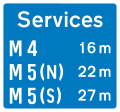 Availability of motorway service areas ahead with distances
Availability of motorway service areas ahead with distances Availability of motorway service areas ahead with distances and names of operators
Availability of motorway service areas ahead with distances and names of operators
 Additional traffic lane joining from the right ahead
Additional traffic lane joining from the right ahead
Motorway Signals
Motorway conditions
 Leave motorway at next exit
Leave motorway at next exit Risk of Fog ahead. Proceed with caution
Risk of Fog ahead. Proceed with caution Risk of Ice ahead. Proceed with caution
Risk of Ice ahead. Proceed with caution End of temporary restrictions
End of temporary restrictions
Temporary Speed Advisories
 Temporary Speed advised of 50 mph due to prevailing traffic or weather conditions.
Temporary Speed advised of 50 mph due to prevailing traffic or weather conditions.
Lane Restrictions
 Lane 2 is closed ahead. Use lane 1 and proceed with caution.
Lane 2 is closed ahead. Use lane 1 and proceed with caution. Lane 2 and 3 closed ahead. Use lane 1 and proceed with caution.
Lane 2 and 3 closed ahead. Use lane 1 and proceed with caution. Lane 1 closed. Use lanes 2, 3 and 4, Proceed with caution
Lane 1 closed. Use lanes 2, 3 and 4, Proceed with caution
Motorway Closed
 Do not enter the traffic lane directly below[lower-alpha 1]
Do not enter the traffic lane directly below[lower-alpha 1] Both lanes closed. Do not enter the motorway when the red lamps are flashing in pairs from side to side
Both lanes closed. Do not enter the motorway when the red lamps are flashing in pairs from side to side All 3 lanes closed Do not enter the motorway when the red lamps are flashing in pairs from side to side
All 3 lanes closed Do not enter the motorway when the red lamps are flashing in pairs from side to side All 4 lanes closed. Do not enter the motorway when the red lamps are flashing in pairs from side to side
All 4 lanes closed. Do not enter the motorway when the red lamps are flashing in pairs from side to side
- A previous signal may direct you into an adjacent lane. More than one lane may be closed to traffic. If all lanes display a red cross, the motorway ahead is closed. Motorists caught using the traffic lane are subject to a fine of £100 and will receive points on their licence.[19]
Directional road signs
The term "directional sign" covers both Advance Direction Signs (ADS), placed on the approach to a junction,[17] and Direction Signs (DS) at the junction itself, showing where to turn.[17] A DS has a chevron (pointed) end, and this type is also referred to as a flag-type sign.[18]
 300 yards to a roundabout or the next point at which traffic may leave a primary route
300 yards to a roundabout or the next point at which traffic may leave a primary route 200 yards to a roundabout or the next point at which traffic may leave a primary route
200 yards to a roundabout or the next point at which traffic may leave a primary route 100 yards to a roundabout or the next point at which traffic may leave a primary route
100 yards to a roundabout or the next point at which traffic may leave a primary route Junction ahead of a primary route with a non-primary route through a town or village that has been by-passed
Junction ahead of a primary route with a non-primary route through a town or village that has been by-passed Additional traffic lanes joining from the right ahead. Traffic in the right-hand lane joins the main carriageway. Traffic on the main carriageway has priority over joining traffic (primary route)
Additional traffic lanes joining from the right ahead. Traffic in the right-hand lane joins the main carriageway. Traffic on the main carriageway has priority over joining traffic (primary route) Additional traffic lane joining from the left in 200 yards. Traffic on the main carriageway had priority over joining traffic from the right-hand lane of the slip road (primary routes)
Additional traffic lane joining from the left in 200 yards. Traffic on the main carriageway had priority over joining traffic from the right-hand lane of the slip road (primary routes)
Tourist Destinations

 Camping and caravan site 300 yards ahead
Camping and caravan site 300 yards ahead Steam railway tourist attraction 300 yards ahead
Steam railway tourist attraction 300 yards ahead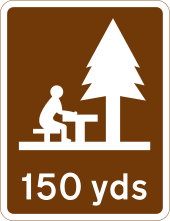 Picnic area 150 yards ahead
Picnic area 150 yards ahead Direction to tourist attraction indicated by a symbol
Direction to tourist attraction indicated by a symbol Direction along a route passing through places of interest recognised by a regional tourist
Direction along a route passing through places of interest recognised by a regional tourist Direction and distance to a picnic area
Direction and distance to a picnic area Direction and distance to a Tourist Information point or centre
Direction and distance to a Tourist Information point or centre Junction ahead from a motorway exit slip road to the tourist attractions shown
Junction ahead from a motorway exit slip road to the tourist attractions shown Direction of the route to a tourist attraction for pedestrians
Direction of the route to a tourist attraction for pedestrians Junction ahead leading to a tourist attraction
Junction ahead leading to a tourist attraction Youth hostel 200 yards in the direction indicated
Youth hostel 200 yards in the direction indicated Junction ahead from a motorway exit slip road to the tourist attractions shown
Junction ahead from a motorway exit slip road to the tourist attractions shown Historic castle tourist attraction 10 miles ahead
Historic castle tourist attraction 10 miles ahead Tourist information
Tourist information Stopping place for buses used for carrying tourists to allow passengers to take photographs
Stopping place for buses used for carrying tourists to allow passengers to take photographs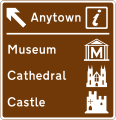 Motorway junction ahead leading to a town or geographical area containing several tourist attractions and a Tourist Information Point or Centre
Motorway junction ahead leading to a town or geographical area containing several tourist attractions and a Tourist Information Point or Centre Distance ahead to a parking place with a Tourist Information Point, picnic site, public telephone, public toilets and viewpoint
Distance ahead to a parking place with a Tourist Information Point, picnic site, public telephone, public toilets and viewpoint
Diversion routes
Diversion routes are marked with black symbols on a yellow patch (square, triangle, circle, or diamond). These mark diversionary routes in the event that the road ahead is closed for any reasons. Motorists can navigate following the symbol and can find their way back to the original road at a junction above the closure. The four symbols may be a solid shape or just outlines. They are most commonly placed on directional signs, following the route number (e.g. A 25) but may be free standing.
Motorway exits have trigger signs that are normally covered. In the event of a closure, the sign is uncovered and will say, for instance, "To rejoin M6 follow (symbol)". Following the symbol will allow rejoining at a later junction.[20]
On minor roads a simple black on yellow sign with an arrow and the word Diversion is used, as here.
 Solid Circle - Emergency diversion route for motorway and other main road traffic
Solid Circle - Emergency diversion route for motorway and other main road traffic Solid Triangle - Emergency diversion route for motorway and other main road traffic
Solid Triangle - Emergency diversion route for motorway and other main road traffic hollow Square - Emergency diversion route for motorway and other main road traffic
hollow Square - Emergency diversion route for motorway and other main road traffic hollow Diamond - Emergency diversion route for motorway and other main road traffic
hollow Diamond - Emergency diversion route for motorway and other main road traffic Diversion trigger sign - Main road closed, follow diversion to arrive at the same location
Diversion trigger sign - Main road closed, follow diversion to arrive at the same location For triangle diversion, turn right
For triangle diversion, turn right Diversion sign on minor roads or for road works starting to left.
Diversion sign on minor roads or for road works starting to left.
Information signs
Informational signs are usually rectangular and generally blue with white text.
 One-way traffic
One-way traffic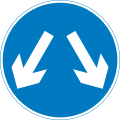
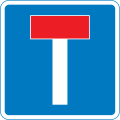 No through road
No through road Unsuitable for heavy goods vehicles
Unsuitable for heavy goods vehicles Unsuitable for long vehicles
Unsuitable for long vehicles No hard shoulder for 400 yards
No hard shoulder for 400 yards Location of weight restriction ahead with indication of an alternative route (may show a different restriction)
Location of weight restriction ahead with indication of an alternative route (may show a different restriction)
Roadworks and temporary signs
Roadworks are normally signalled with a triangular, red-bordered warning format is used to indicate that there are works ahead. The graphic is of a man digging. Within the roadworks, diversions and other instructions to drivers are normally given on yellow signs with black script.[23]
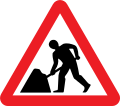 Road works
Road works Loose chippings
Loose chippings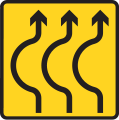 Lanes bend ahead
Lanes bend ahead Restrictions apply. No vehicles over width shown
Restrictions apply. No vehicles over width shown Diversion for motorists travelling to destination
Diversion for motorists travelling to destination Temporary Advisory speed limit in miles per hour
Temporary Advisory speed limit in miles per hour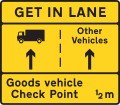 Get in Lane. HGV use left lane, all other vehicles use right lane
Get in Lane. HGV use left lane, all other vehicles use right lane Police accident
Police accident
Street name signs
Legally street name signs are not defined as traffic signs in the United Kingdom; this therefore gives authorities flexibility on the design and placement of them. They can be fixed to a signpost, wall, lamp column, or building. The text can be in many different fonts but normally either the Transport typeface used on road signs or the serif font designed by David Kindersley. In many areas, the sign will also show the name of the local authority, its coat of arms, or part of the street’s postcode.
Location identifiers
Numbered location markers of one type or another are used to identify specific locations along a road. Historically, milestones were used, but since the early 20th century they fell into disuse. However, for administrative and maintenance purposes, distance marker posts and driver location signs have been erected on motorways and certain dual carriageways.[24] The numbers on distance marker posts are embedded into emergency roadside telephone numbers and are used by the emergency services to pinpoint incidents.[25] The advent of the mobile phone meant that drivers were not accessing location information embedded into motorway emergency telephone systems, and since 2007 driver location signs have been erected on many motorways. These contain important information about the location and carriageway direction.
Retired signs (post-Worboys)
.svg.png) Stop (until 1975)
Stop (until 1975).svg.png) Crossroads ahead (until 1975)
Crossroads ahead (until 1975).svg.png) T-junction ahead (until 1975)
T-junction ahead (until 1975).svg.png) Side road ahead (until 1975)
Side road ahead (until 1975).svg.png) Staggered crossroads ahead (until 1975)
Staggered crossroads ahead (until 1975).svg.png) Series of bends ahead (until 1975). This sign is rarely still used today (for sharp/dangerous bends)
Series of bends ahead (until 1975). This sign is rarely still used today (for sharp/dangerous bends).png) Lorries prohibited (until 1975)
Lorries prohibited (until 1975).png) Buses and coaches prohibited (until 1975)
Buses and coaches prohibited (until 1975).svg.png) Steep hill upwards ahead (replaced with % gradient in 1975)
Steep hill upwards ahead (replaced with % gradient in 1975).svg.png) Steep hill downwards ahead (replaced with % gradient in 1975)
Steep hill downwards ahead (replaced with % gradient in 1975)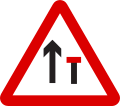 Right-hand lane of a 2 lane dual carriageway closed ahead (1975-1981)
Right-hand lane of a 2 lane dual carriageway closed ahead (1975-1981) Traffic merges from the left (until 1994)
Traffic merges from the left (until 1994) Traffic merges onto the main carriageway (until 1994)
Traffic merges onto the main carriageway (until 1994).svg.png) Icy conditions may exist (until 1994)
Icy conditions may exist (until 1994).svg.png) Change of carriageway ahead (1975-1994)
Change of carriageway ahead (1975-1994)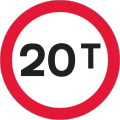 Vehicles and loads exceeding weight in tons indicated prohibited (1981-1994)
Vehicles and loads exceeding weight in tons indicated prohibited (1981-1994).svg.png) Ungated Level Crossing with more than one track (1981)
Ungated Level Crossing with more than one track (1981)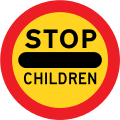 Stop - children crossing (until 1994)
Stop - children crossing (until 1994)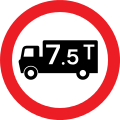 Vehicles exceeding the indicated unladen weight in tons prohibited (replaced with metric tonne equivalent in 2011)
Vehicles exceeding the indicated unladen weight in tons prohibited (replaced with metric tonne equivalent in 2011) Vehicles exceeding an indicated gross weight prohibited from crossing bridge (replaced with metric tonne equivalent in 2011)
Vehicles exceeding an indicated gross weight prohibited from crossing bridge (replaced with metric tonne equivalent in 2011)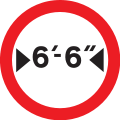 Vehicles exceeding width indicated prohibited (defunct imperial only sign, new signs must show both metric and imperial)
Vehicles exceeding width indicated prohibited (defunct imperial only sign, new signs must show both metric and imperial)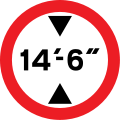 Vehicles exceeding height indicated prohibited (defunct imperial only sign, new signs must show both metric and imperial)
Vehicles exceeding height indicated prohibited (defunct imperial only sign, new signs must show both metric and imperial)
Northern Ireland
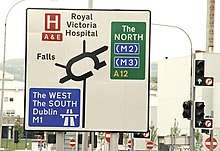
The designs of road signs in Great Britain as prescribed in the Traffic Signs Regulations and General Directions (TSRGD) apply specifically to England, Scotland and Wales.[26] These regulations do not extend to Northern Ireland. Traffic signs in Northern Ireland are prescribed by The Traffic Signs Regulations (Northern Ireland) 1997 and are administered by the Northern Ireland Assembly.
Northern Ireland signs are broadly the same as those in Great Britain, although changes made in Great Britain are often not made in Northern Ireland at the same time. One example is the series of bends ahead sign, which was removed from TSRGD in 1975 but only removed from the Northern Ireland regulations in 1979.[27]
| Territory | Drives on... | Speed units | Warning sign style |
|---|---|---|---|
Northern Ireland |
left | mph |  |
Outside the United Kingdom
Crown dependencies

The designs of road signs as prescribed in the Traffic Signs Regulations and General Directions (TSRGD) do not extend to other territories that come under the jurisdiction of the Crown. Road signs in the Channel Islands and the Isle of Man are under the jurisdiction of their local legislatures. Although the policy in these territories is to align their road signs with those prescribed in the TSRGD, small variations may be seen.
The Tynwald (Isle of Man Parliament), through its Traffic Signs (Application) Regulations 2003, explicitly included Part I of the TSRGD into Manx law, but not the other parts of that legislation. One of the consequences of this partial incorporation is that while in England and Wales speed limit signs had to appear on both sides of a carriageway until 2016, this was not necessary for the Isle of Man.[28] Likewise, an all-way stop is permissible in the Isle of Man, whilst it has been prohibited in Great Britain since 2002.
The use of the derestricted sign differs according to jurisdiction, in the Isle of Man it means no speed limit applies, whereas in Jersey it denotes a 40 mph speed limit, which is the highest permitted speed on the island.[29] [30]
In Jersey, there is no requirements for speed limits as in the UK. As such, repeater signs are never used for 40 mph, and sometimes used for 30 mph where there are street lights, which would not be necessary in the UK. Furthermore, there is no requirement that speed limit signs appear on both sides of the carriageway (as such they often only appear on one).
The Bailiwick of Guernsey, devolves road markings and signs to Alderney and Sark. Sark does not permit road transport, aside from cycles and farm vehicles. Alderney has some different road markings, but the signs are broadly the same as Guernsey.
Guernsey and Jersey has a unique sign "Filter in turn", which is a give way without priority. It is similar to the all-way stops found elsewhere in the world, although there is no requirement to halt.[31]
Weight restriction signs in Guernsey use hundredweight as a unit rather than the tonne, although one CWT was redefined as exactly 50.8 kg in 1991.[32]
| Territory | Drives on... | Speed units | Warning sign style |
|---|---|---|---|
Isle of Man |
left | mph |  |
Jersey |
left | mph |  |
Guernsey |
left | mph |  |
Alderney |
left | mph |  |
Overseas territories
The Overseas territories have much more autonomy regarding their use of signs and these can vary quite significantly from those used in Great Britain.
Akrotiri and Dhekelia
Road signs in Akrotiri and Dhekelia, on Cyprus, are controlled by the Ministry of Defence and maintain the same designs as the Republic of Cyprus.[33] Speeds are in kilometres per hour, distances are in kilometres. Some signs are in Turkish as well as English and Greek.
Anguilla
Anguilla mostly uses the same road signs as the United Kingdom with minor differences. Anguilla's roads occasionally cross large dish drains requiring a vehicle to slow down to cross. Because of this, the territory has its own unique dip sign.

Ascension Island
Ascension Island mainly uses signs similar to the UK's, but the yellow diagonal signs common to the USA are also found on the island.[34]

Bermuda
Bermuda mostly uses the same style as the United Kingdom, with some exceptions. Speed limit signs are in kilometres per hour, and all limit signs have this marked. No entry signs have "NO ENTRY" written in black down the centre as was often used in the UK prior to 1965. Goods vehicles are prohibited by class rather than weight: a list of prohibited vehicle classes will usually accompany a generic "no lorries" sign. Bermuda still uses the Z-bend sign, phased out in the UK since 1975.
.svg.png) 20 km/h speed limit sign
20 km/h speed limit sign.svg.png) No entry sign
No entry sign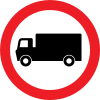 Goods vehicles prohibited sign
Goods vehicles prohibited sign.svg.png) Series of bends ahead (Z-bend) sign
Series of bends ahead (Z-bend) sign
British Indian Ocean Territory
The British Indian Ocean Territory's road signs are modelled on those of the USA's Manual on Uniform Traffic Control Devices.
Cayman Islands
The road signs of the Cayman Islands are similar to the UK's, the only main difference is some signs have allowable alternatives from the USA's Manual on Uniform Traffic Control Devices, mainly for parking restriction signs. The warning sign for dead ends is one of the only signs to follow the US standard in the Road Code, although other US-influenced signs are listed for use near schools.[35]
In practice, the Transport typeface is not used and signs are written in all-caps. Pedestrian crossings are often marked with a US-style sign instead of a Belisha beacon.[36]
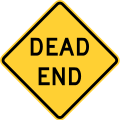 Warning sign
Warning sign Information sign for vehicles
Information sign for vehicles
Falkland Islands
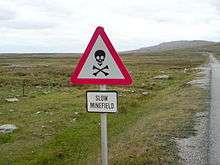
The Falkland Islands' road signs are similar to the UK. There is an additional road sign used in the Falklands to denote a minefield.
Gibraltar
The road signs of Gibraltar are similar to the UK, with some signs being reversed to reflect driving on the opposite side of the road. There are some warning signs specific to Gibraltar, mainly to do with the unique wildlife of the territory. Speed limits and distances are in metric, in keeping with the rest of the Iberian Peninsula. However, height and width clearance warning and regulatory signs are both in imperial and metric.[37]
Montserrat
The road signs of Montserrat are similar to those of the UK. No entry signs have "NO ENTRY" written in red down the centre, similar to the design used in the Bahamas.

Pitcairn Island
Road transport in Pitcairn is primarily by quad bike. Signs are modelled on those of New Zealand, although they are not kept in step with New Zealand updates. Pitcairn's uses a unique slow down sign seen in neither the UK nor New Zealand – a red octagon with "SLOW DOWN" in white.[38]
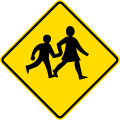 New Zealand's old watch for children sign is still used in Pitcairn
New Zealand's old watch for children sign is still used in Pitcairn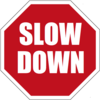 The slow down sign, unique to Pitcairn
The slow down sign, unique to Pitcairn
Saint Helena
The road signs on Saint Helena are similar to the UK's.
South Georgia and the South Sandwich Islands
South Georgia and the South Sandwich Islands inherited the traffic regulations of the Falkland Islands when it was made a separate territory in 1985. There are very few roads on the island and they are all gravel and unmarked.
Turks and Caicos Islands
The lack of road signs and official street names in the Turks and Caicos Islands was blamed for emergency vehicles not reaching their destination promptly, the government has since embarked on a programme of labelling roads and installing signs.[39] Roads are labelled in a similar way to the US and Canada. Road signs are similar to those of the UK, although older MUTCD-influenced signs, including US-style speed limit signs, have not been actively replaced and are still seen.
Brown signs are sometimes erroneously used instead of green to denote primary routes. Officially, green is used for primary routes and white for local routes, as in the UK. There are no traffic lights in the Turks and Caicos Islands, most intersections are roundabouts. [39][40]
Virgin Islands
The road signs of the Virgin Islands are similar to those of the USA.[41] The BVI drivers manual lists British-influenced signage with occasional differences,[42] but in reality, all signs installed follow the Manual on Uniform Traffic Control Devices.
In 2018, new legislation was introduced in the Virgin Islands requiring that speed limits be labelled in both mph and km/h.[43]
 Road sign that appears in the BVI drivers manual
Road sign that appears in the BVI drivers manual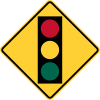 Road sign that is most commonly installed in the Virgin Islands
Road sign that is most commonly installed in the Virgin Islands
| Territory | Drives on... | Speed units | Warning sign style |
|---|---|---|---|
Akrotiri and Dhekelia |
left | km/h |  |
Anguilla |
left | mph |  |
Ascension Island |
left | mph |  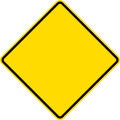 |
Bermuda |
left | km/h |  |
British Indian Ocean Territory |
right | mph |  |
Cayman Islands |
left | mph |  |
Falkland Islands |
left | mph |  |
Gibraltar |
right | km/h |  |
Montserrat |
left | mph |  |
Pitcairn Island |
left | km/h |  |
Saint Helena |
left | mph |  |
South Georgia |
left | mph |  |
Tristan da Cunha |
left | mph |  |
Turks and Caicos Islands |
left | mph |   |
Virgin Islands |
left | mph and km/h |  |
See also
References

- Oddy, N 'This Hill is Dangerous' in 'Technology and Culture' 56/2, April 2015 pp335-369
- "Google Street View of location". Retrieved 28 February 2014.
- "Imperial War Museum Collection Search". Photograph number HU 49250, A signpost in Surrey being dismantled (image). Retrieved 20 February 2020.
- Description of the work done by Kinneir and Calvert
- https://www.gov.uk/government/publications/traffic-signs-manual
- "Chapter 7". Traffic Signs Manual (PDF). London: The Stationery Office. 19 October 2005. p. 8. ISBN 978-0-11-552480-6. Retrieved 19 October 2014.
- "Q&A: Pounds, pints and the EU". BBC News. British Broadcasting Corporation. 11 September 2007. Retrieved 29 December 2007.
- "Height and width road signs to display metric and imperial". BBC News. 8 November 2014. Retrieved 8 November 2014.
- Department of Transport: "Local Transport Note 1/94", page 1. HMSO, July 1994.
- "Chapter 7". Traffic Signs Manual (PDF). London: The Stationery Office. 19 October 2005. p. 16. ISBN 978-0-11-552480-6. Retrieved 19 October 2014.
- UK Statutory Instrument:"The Traffic Signs Regulations and General Directions 2002", The Stationery Office, 2002
- "Dartmoor Leaflet Part 2" (PDF). Dartmoor National Park Authority. Retrieved 16 September 2011.
- Road Safety GB 31 March 2016
- "Reflectorisation of Traffic Signs" (PDF). www.dft.gov.uk. Highways Agency, etc. Retrieved 19 October 2014.
- "Road Traffic Regulation Act: Section 81", legislation.gov.uk, The National Archives, 1984 c. 27 (s. 81), retrieved 2 May 2020
- "Road Traffic Regulation Act: Section 82", legislation.gov.uk, The National Archives, 1984 c. 27 (s. 82), retrieved 2 May 2020
- "Chapter 7". Traffic Signs Manual (PDF). London: The Stationery Office. 19 October 2005. p. 14. ISBN 978-0-11-552480-6. Retrieved 19 October 2014.
- "Chapter 7". Traffic Signs Manual (PDF). London: The Stationery Office. 19 October 2005. p. 15. ISBN 978-0-11-552480-6. Retrieved 19 October 2014.
- "£100 fine for flouting red X motorway signs planned". www.msn.com. Retrieved 20 October 2017.
- Marshall, Chris. "Emergency Diversion Routes". Roads.org.uk. Retrieved 19 October 2018.
- "Chapter 3". Traffic Signs Manual (PDF). London: The Stationery Office. 2019. p. 36, section 4.7.4. ISBN 9780115532238. Retrieved 8 May 2020.
- "The Traffic Signs Regulations and General Directions 2016: Schedule 11", legislation.gov.uk, The National Archives, 22 April 2016, SI 2016/362 (sch. 11), retrieved 8 May 2020
- "Chapter 7". Traffic Signs Manual (PDF). London: The Stationery Office. 19 October 2005. pp. 116–117. ISBN 978-0-11-552480-6. Retrieved 19 October 2014.
- Highway Agency. "Identification of Incident Locations". Archived from the original on 17 March 2010. Retrieved 25 July 2009.
- Highway Agency. "Driver Location Signs (March 2007)". Archived from the original on 8 June 2009. Retrieved 25 July 2009.
- "Statutory Instrument 2002 No. 3113; The Traffic Signs Regulations and General Directions 2002". Controller of HMSO. 16 December 2002.
- "The Traffic Signs Regulations (Northern Ireland) 1979". 1979. Retrieved 29 October 2018.
- "THE CHIEF CONSTABLE v MITCHELL & OTRS". The Isle of Man Courts. 11 June 2009. Retrieved 2 February 2010.
- "The Manx Highway Code" (PDF). The Isle of Man Government. Retrieved 29 October 2018.
- "The Manx Highway Code" (PDF). The Isle of Man Government. Retrieved 29 October 2018.
- "Driving in Guernsey is different". The States of Guernsey. Retrieved 2 November 2018.
- "The Weights and Measures (Guernsey and Alderney) Law, 1991". Retrieved 29 October 2018.
- "Website of the Sovereign British Area, Cyprus". Administration of the Sovereign British Area, Cyprus. Retrieved 8 December 2009.
- "Drive to work every morning Ascension Island". Retrieved 29 October 2018.
- "Traffic Control Regulations, 2012" (PDF). Retrieved 4 June 2020.
- "Driving Georgetown to Seven Mile Beach - Grand Cayman". Retrieved 30 October 2018.
- "Getting Around - Driving". Gibraltar.gi Tourism. Retrieved 8 December 2009.
- "Britain's Treasure Islands". Britain's Treasure Islands. Retrieved 30 October 2018.
- "Driving in the Turks and Caicos Islands". Retrieved 6 November 2018.
- "Traffic Tips For Visitors". Retrieved 6 November 2018.
- "Driving Tortola". Retrieved 27 October 2018.
- "BVI Drivers' Manual". Retrieved 25 October 2018.
- "Amended Vehicles & Road Traffic Legislation in effect". 25 October 2018. Retrieved 29 October 2018.
External links
| Wikimedia Commons has media related to Road signs in the United Kingdom. |
- Official government websites
- Department for Transport traffic signs and signals index page
- The Traffic Signs Regulations and General Directions 2002
- The Highway Code - Traffic signs section
- Know Your Traffic Signs - A Department for Transport publication detailing common road signs and their meanings.
- The Traffic Signs Regulations and General Directions 2016
- History
- War to Worboys — a Roads.org.uk article about the Worboys Committee.
- Other resources
- Traffic signs: report of the committee on traffic signs for all-purpose roads – The 'Worboys report', a 1963 report, at the Internet Archive
- Motorway Signs: Final Report of Advisory Committee for Traffic Signs on Motorways - The 'Anderson Report', a 1962 report for motorway signs, at the Internet Archive
- Institute of Highway Engineers sign design technical gateway
- British Road Design Project, curated by Patrick Murphy, celebrating the 50th Anniversary of the British Road Sign at the Design Museum, London
.svg.png)
.svg.png)
.svg.png)
.svg.png)
.svg.png)
.svg.png)
.svg.png)
.svg.png)
.svg.png)
.svg.png)
.svg.png)
.svg.png)